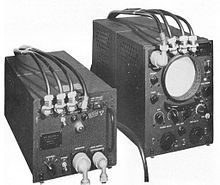
Back نظام لوران الملاحي Arabic LORAN Catalan LORAN Czech LORAN Danish LORAN German Συσκευή Λοράν Greek LORAN Spanish LORAN EU Loran Finnish LORAN French

LORAN (Long Range Navigation)[a] was a hyperbolic radio navigation system developed in the United States during World War II. It was similar to the UK's Gee system but operated at lower frequencies in order to provide an improved range up to 1,500 miles (2,400 km) with an accuracy of tens of miles. It was first used for ship convoys crossing the Atlantic Ocean, and then by long-range patrol aircraft, but found its main use on the ships and aircraft operating in the Pacific theater during World War II.
LORAN, in its original form, was an expensive system to implement, requiring a cathode ray tube (CRT) display. This limited use to the military and large commercial users. Automated receivers became available in the 1950s, but the same improved electronics also opened the possibility of new systems with higher accuracy. The U.S. Navy began development of Loran-B, which offered accuracy on the order of a few tens of feet, but ran into significant technical problems. The U.S. Air Force worked on a different concept, Cyclan, which the Navy took over as Loran-C, which offered longer range than LORAN and accuracy of hundreds of feet. The U.S. Coast Guard took over operations of both systems in 1958.
In spite of the dramatically improved performance of Loran-C, LORAN, now known as Loran-A (or "Standard LORAN"), would become much more popular during this period. This was due largely to the large numbers of surplus Loran-A units released from the Navy as ships and aircraft replaced their sets with Loran-C. The widespread introduction of inexpensive microelectronics during the 1960s caused Loran-C receivers to drop in price dramatically, and Loran-A use began to rapidly decline. Loran-A was dismantled starting in the 1970s; it remained active in North America until 1980 and the rest of the world until 1985. A Japanese chain remained on the air until 9 May 1997, and a Chinese chain was still listed as active as of 2000[update].[citation needed]
Loran-A used two frequency bands, at 1.85 and 1.95 MHz. These same frequencies were used by radio amateurs, in the amateur radio 160-meter band,[2] and amateur operators were under strict rules to operate at reduced power levels to avoid interference; depending on their location and distance to the shore, U.S. operators were limited to maximums of 200 to 500 watts during the day and 50 to 200 watts at night.[3]
The "National Timing Resilience and Security Act" of 2017, proposed repurposing LORAN real estate and radio spectrum for a new terrestrial navigation system as a backup for the United States in case of a GPS outage caused by space weather or attack.[4][5] eLoran has been proposed as a viable technology, which is already being pursued by other countries.
- ^ Position, Navigation, and Timing Technologies in the 21st Century: Integrated Satellite Navigation, Sensor Systems, and Civil Applications, Volume 2. United Kingdom, Wiley, 2021. 1283.
- ^ Dickinson 1959.
- ^ Proc 2012.
- ^ Martin, Aaron (19 December 2017). "Senate bill would require establishment of land-based alternative to GPS satellite timing signals". Homeland Preparedness News. Archived from the original on 15 January 2018.
- ^ "Coast Guard Authorization Act of 2017".
Cite error: There are <ref group=lower-alpha> tags or {{efn}} templates on this page, but the references will not show without a {{reflist|group=lower-alpha}} template or {{notelist}} template (see the help page).